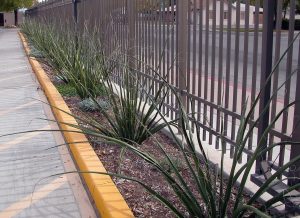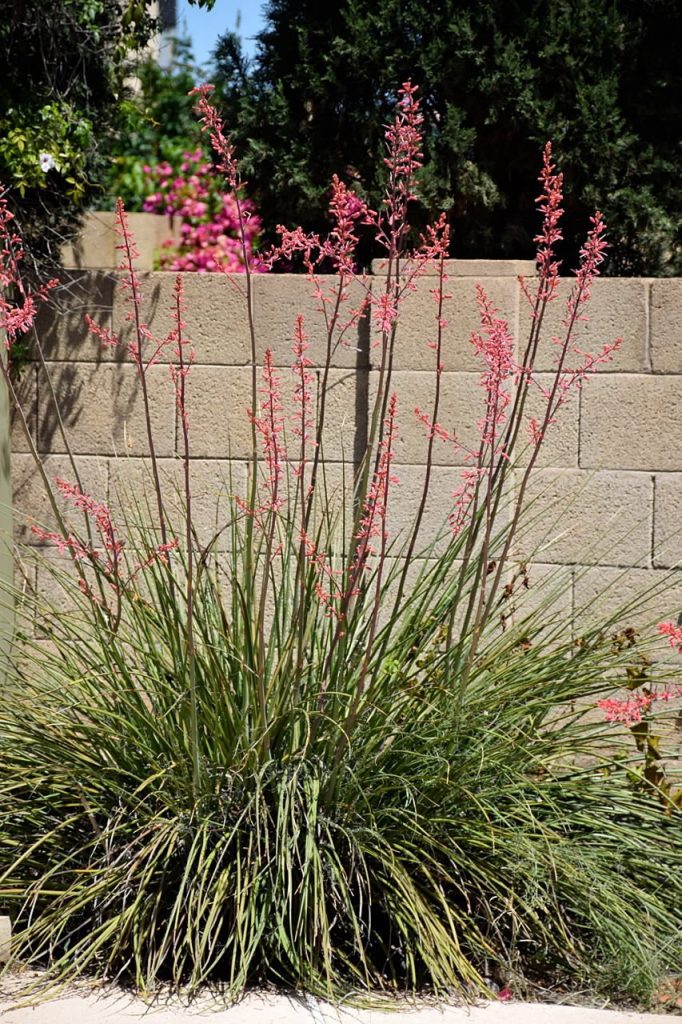The strong vertical form of hesperaloe with its spectacular flower spikes makes this clumping, evergreen perennial an ideal accent plant for gardens. While not a true yucca or aloe, it is related to yuccas and agaves, and like its relatives, is a carefree, non-demanding plant. Hesperaloes are extremely hardy, tolerating both heat and cold well in our climate. Hesperaloes prefer a sunny location and mature more rapidly with well-drained soils, but will adapt to heavy soils if not over-watered.
Hummingbirds are attracted to the tubular flowers that occur in several colors, ranging from creams to yellow, to bright reds. It’s long, thornless, sword-like leaves work well with gray-leafed shrubs, such as leucophyllum, and look striking when emerging from a patch of flowering groundcovers or wildflowers. Established plants provide long-lasting summer color. This plant adapts to annual rainfall, but will look best with minimal supplemental irrigation during extended hot, dry periods. Fall and winter are ideal times for planting.
Red Yucca, Hesperaloe parviflora
This attractive accent plant is irresistible to hummingbirds. Its coral red flower spikes appear in the spring and last through fall, reaching heights from 4 to 8 feet. The narrow, green leaves can reach lengths of 3 feet, providing both textural and color contrast in the landscape.
Red yuccas can be used to enhance either the Mediterranean or Sonoran landscape image. The soft, fleshy leaves allow this plant to be used in high traffic areas and around swimming pools. Hesperaloe parviflora tolerates almost any soil type and temperatures to zero degrees Fahrenheit. It prefers full sun and requires little supplemental water except during the dry months of summer.
Giant Hesperaloe, Hesperaloe funifera

Giant hesperaloe is much larger than red yucca, forming a clump up to 6 feet in height and width when mature. The long, thick, straight leaves of the giant hesperaloe, adorned by white fibers, make it an interesting bold accent in the transitional and oasis zones of the landscape. The creamy white flowers bloom sporadically, spring through fall, on stalks that reach heights of 10 to 15 feet. Avoid planting giant hesperaloe close to walkways and pedestrian areas because of its sharp-tipped leaves and large size. Like red yucca, Hesperaloe funifera performs best with some supplemental waterings during the dry summer months.
Did you know that up to 70% of water use is outdoors? That’s why we love desert plants and feature them each month. Find even more beautiful plants on our Arizona Low-Water-Use Plants page, and visit our page on Choosing and Planting Low Water-Use Plants for tips on plant selection and how to plant properly.”
TOP FEATURED PHOTO: Red Yucca by Steve Priebe.
This feature is based on a concept and text originally developed jointly by the Arizona Nursery Association and the Arizona Municipal Water Users Association (AMWUA) with partial funding from the Arizona Department of Water Resources.


